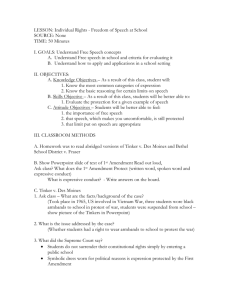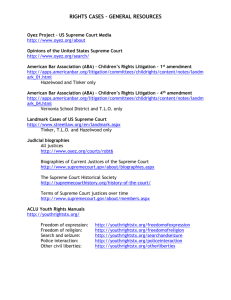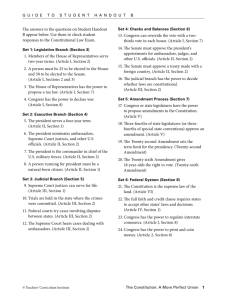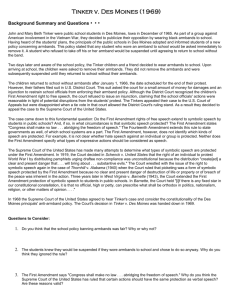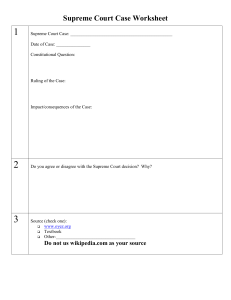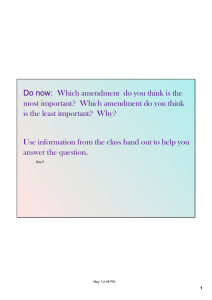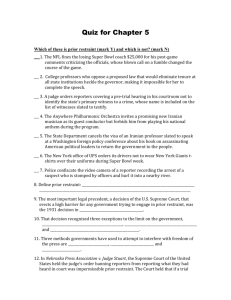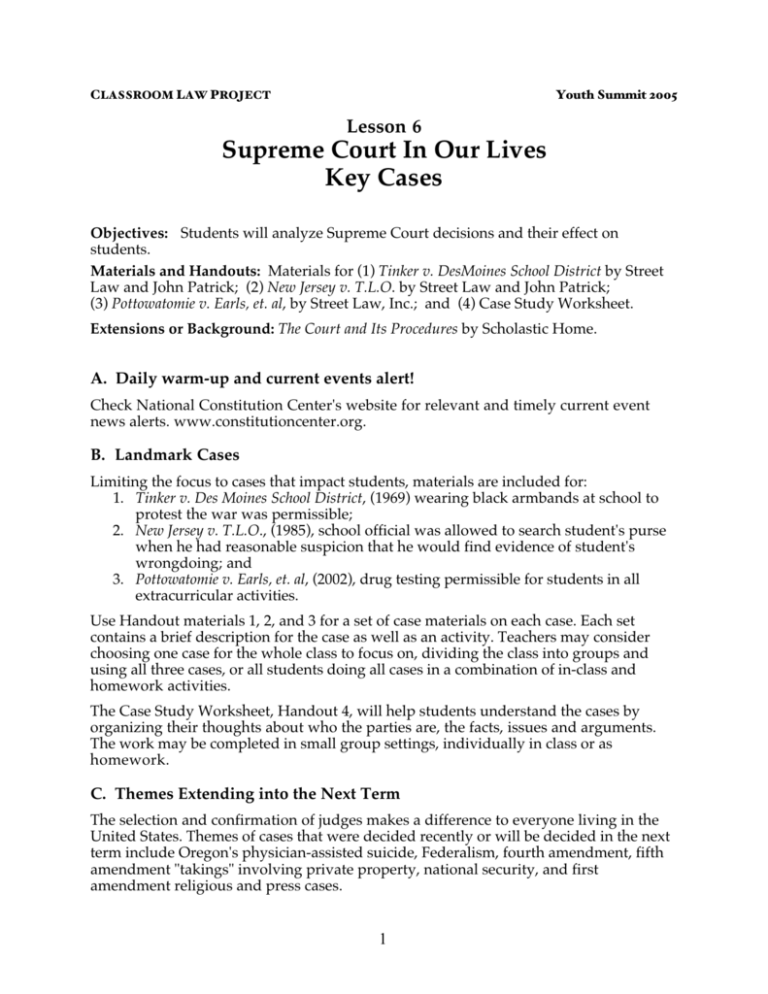
CLASSROOM LAW PROJECT
Youth Summit 2005
Lesson 6
Supreme Court In Our Lives
Key Cases
Objectives: Students will analyze Supreme Court decisions and their effect on
students.
Materials and Handouts: Materials for (1) Tinker v. DesMoines School District by Street
Law and John Patrick; (2) New Jersey v. T.L.O. by Street Law and John Patrick;
(3) Pottowatomie v. Earls, et. al, by Street Law, Inc.; and (4) Case Study Worksheet.
Extensions or Background: The Court and Its Procedures by Scholastic Home.
A. Daily warm-up and current events alert!
Check National Constitution Center's website for relevant and timely current event
news alerts. www.constitutioncenter.org.
B. Landmark Cases
Limiting the focus to cases that impact students, materials are included for:
1. Tinker v. Des Moines School District, (1969) wearing black armbands at school to
protest the war was permissible;
2. New Jersey v. T.L.O., (1985), school official was allowed to search student's purse
when he had reasonable suspicion that he would find evidence of student's
wrongdoing; and
3. Pottowatomie v. Earls, et. al, (2002), drug testing permissible for students in all
extracurricular activities.
Use Handout materials 1, 2, and 3 for a set of case materials on each case. Each set
contains a brief description for the case as well as an activity. Teachers may consider
choosing one case for the whole class to focus on, dividing the class into groups and
using all three cases, or all students doing all cases in a combination of in-class and
homework activities.
The Case Study Worksheet, Handout 4, will help students understand the cases by
organizing their thoughts about who the parties are, the facts, issues and arguments.
The work may be completed in small group settings, individually in class or as
homework.
C. Themes Extending into the Next Term
The selection and confirmation of judges makes a difference to everyone living in the
United States. Themes of cases that were decided recently or will be decided in the next
term include Oregon's physician-assisted suicide, Federalism, fourth amendment, fifth
amendment "takings" involving private property, national security, and first
amendment religious and press cases.
1
D. Vocabulary
First amendment - freedom of expression, and fourth amendment - search and seizure
are two of many examples.
E.
Homework / Journal Entry
Extensions
1. For more information on the TLO and Tinker cases, go to the Street Law and U.S.
Supreme Court Historical Society website. You will find a wealth of materials including:
excerpts from the majority, concurring and dissenting opinions; link to the actual case;
materials geared for different academic abilities, and more.
For Tinker (armband case): http://www.landmarkcases.org/tinker/home.html.
For TLO (purse search at school case):
http://www.landmarkcases.org/newjersey/home.html.
2. The Bill of Rights Institute offers consistently excellent materials for teachers. See its
section on landmark cases for alternative teaching strategies including case study
method. www.billofrightsinstitute.org.
3. See Backgrounder on The Court and Its Procedures for a look at the actual process of
when the Court hears cases.
4. This is the ideal time to invite a judge, lawyer, or law student to class.
Journal
Choose the case you think has the most impact on students. Why?
2
CLASSROOM LAW PROJECT
Lesson 6 - Handout 1
Youth Summit 2005
Tinker v. Des Moines Independent
Community School District
-John J. Patrick, The Supreme Court of the United States - A Student Companion,
2nd Ed., Oxford Press
♦
♦
♦
♦
♦
393 U.S. 503 (1969)
Vote: 7-2
For the Court: Fortas
Concurring: Stewart and White
Dissenting: Black and Harlan
In December 1965 some students in Des Moines, Iowa, decided to publicly express their
opposition to the war in Vietnam by wearing black armbands. Des Moines School
Administrators, however. Decided upon a policy that forbade the wearing of a black
armband in school. Students who violate the policy would be suspended from school
until they agreed to comply with the policy.
On December 16, Mary Beth Tinker and Christopher Eckhardt wore armbands to
school. John Tinker did the same thing the next day. As a consequence, the three
students were suspended from school and told not to return unless they removed their
armbands. They stayed away from school until the early part of January 1966.
The three students filed a complaint, through their parents, against the school officials.
They sought an injunction to prevent the officials from punishing them for wearing
black armbands to school.
The Issue Did the school district's policy of prohibiting the wearing of black armbands
in school violate the student' 1st Amendment right to free speech, as extended to the
states through the due process clause of the 14th Amendment?
Opinion of the Court The Court decided by a vote of 7 to 2 that the school district had
violated the students' right to free speech under the 1st and 14th Amendments to the
Constitution. In previous cases, such as Stromberg v. California, the Court had ruled that
1st Amendment free speech rights were incorporated by the due process clause of the
14th Amendment, which provides that no state shall "deprive any person of life, liberty
(such as free speech), or property, without due process of law."
Justice Abe Fortas wrote the majority opinion, in which he stated that the wearing of
black armbands to protest the Vietnam War was a form of "symbolic speech" protected
by the 1st Amendment. Therefore, a public school band on this form of protest was a
violation of the students' right to free speech, as long as the protest did not disrupt the
functioning of the school or violate the rights of other individuals. Justice Fortas wrote,
3
"First Amendment rights applied in light of the special characteristics of the school
environment or are available to teachers and students. It can hardly be argued that
either students or teachers shed their constitutional rights to freedom o speech or
expression at the schoolhouse gate."
Dissent Justice Hugo Black was one of the two dissenters in this case. He wrote:
While I have always believed that under the First and Fourteenth Amendments neither
the State nor the Federal Government has any authority to regulate or censor the content
of speech, I have never believed that any person has the right to give speeches or engage
in demonstrations where he pleases and when he pleases. This Court has already
rejected such a notion . . .
One does not need to be a prophet or the son of a prophet to know that after the Court's
holding today some students in Iowa schools and indeed in all schools will be ready,
able and willing to defy their teachers on practically all orders . . .
This case, therefore, wholly without constitutional reasons in my judgement, subjects all
the public schools in the country to the whims and caprices of their loudest-mouthed,
but maybe not their brightest students.
Significance Tinker is one of the most important cases on the constitutional rights of
students in public schools. It supports a protection of free expression that does not
disrupt the educational purposes of the school or violate the rights of other students.
In subsequent cases involving students in public schools, such as Bethel School District
No. 403 v. Fraser (1986) and Hazelwood School District v. Kuhlmeier (1988), the Court
supported the power of public school officials to limit freedom of expression by
students if such expression -- in these cases, a vulgar speech and the publication of
sensitive material in the student newspaper -- disrupted the schools' educational
mission.
4
CLASSROOM LAW PROJECT
Lesson 6 - Handout 2
Youth Summit 2005
New Jersey v. T.L.O.
-John J. Patrick, The Supreme Court of the United States - A Student Companion, 2nd Ed., Oxford Press
♦ 469 U.S. 325 (1985)
♦ Vote: 6-3
♦ For the Court: White; Dissenting: Stevens, Brennan, and Marshall
A teacher at a New Jersey high school discovered a student smoking cigarettes in a school
bathroom, which was a violation of school rules. The teacher took the student to the
principal's office. The assistant principal questioned the student, who denied she had been
smoking in the bathroom. The school assistant principal then demanded to see her purse.
After opening it, he found cigarettes, cigarette rolling papers that are commonly associated
with the use of marijuana, a pipe, plastic bags, money, a list of students who owed her money,
and two letters that contained evidence that she had been involved in marijuana dealings.
As a result of this search of the student's purse and the seizure of items in it, the state brought
delinquency charges against the student in New Jersey Juvenile Court. The student (identified
in the case only by her initials, T.L.O.) countered with a motion to suppress the evidence found
in her purse as a violation of her constitutional rights against unreasonable and unwarranted
searches and seizures.
The Issue Is the 4th Amendment prohibition of unreasonable and unwarranted searches and
seizures applicable to officials in a public school with regard to its students?
Opinion of the Court The Supreme Court decided that the 4th Amendment prohibition of
unreasonable searches and seizures is applicable to searches conducted by public school officials,
but that in this case a warrantless search o the student's purse was reasonable and permissible.
Justice Byron White wrote the opinion o the Court. He said that school officials may search a
student in school as long as "there are reasonable grounds for suspecting that the search will
turn up evidence that the student has violated or is violating either the law or the rules of the
school."
Dissent Justice John Paul Stevens wrote in the dissent:
The search of a young woman's purse by a school administrator is a serious invasion of her
legitimate expectations of privacy . . . . Because (the student's) conduct was neither unlawful
nor significantly disruptive of school order or the educational process, the invasion of privacy
associated with the forcible opening of TLO's purse was intirely unjustified at its inception . . .
The rule the Court adopts today is so open-ended that it may make the Fourth Amendment
virtually meaningless in the school context. Although I agree that school administrators must
have broad latitude to maintain order and discipline in our classrooms, that authority is not
unlimited.
Significance This decision indicated that the Court did not view the rights of students in
public school as equivalent to the rights of adults in a nonschool setting. Police need to
demonstrate "probable cause" that individuals the search have violated or are violating a law.
School officials, by contrast need to have only "reasonable suspicion" of unlawful conduct to
justify a search of students in school. School authorities, in this view, may restrict the rights of
students in behalf of the school's compelling educational purpose.
8
CLASSROOM LAW PROJECT
Lesson 6 - Handout 4
Youth Summit 2005
Case Study Worksheet
Name
Date
Period
Answer the following questions. Use the reverse if needed.
1. List at least five of the most important facts of the case.
2. What is the issue in this case? What caused the conflict to go to court?
3. Who is the plaintiff/prosecution? What are his or her best arguments?
4. Who is the defendant? What are his or her best arguments?
5. You are the judge in the case. Make a decision and give your reasons for that decision.
16
CLASSROOM LAW PROJECT
BACKGROUNDER - Lesson 6
Youth Summit 2005
The Court and Its Procedures
A term of the Supreme Court begins, by statute, on the first Monday in October. Usually Court sessions
continue until late June or early July. The term is divided between "sittings," when the Justices hear cases
and deliver opinions, and intervening "recesses," when they consider the business before the Court and
write opinions. Sittings and recesses alternate at approximately two-week intervals.
With rare exceptions, each side is allowed 30 minutes' argument; generally, 22 to 24 cases are argued at one
sitting. Since the majority of cases involve the review of a decision of some other court, there is no jury and
no witnesses are heard. For each case, the Court has before it a record of prior proceedings and printed
briefs containing the arguments of each side.
During the intervening recess period, the Justices study the argued and forthcoming cases and work on
their opinions. Each week the Justices must also evaluate more than 110 petitions seeking review of
judgments of state and federal courts to determine which cases are to be granted full review with oral
arguments by attorneys.
When the Court is sitting, public sessions begin promptly at 10 a.m. and continue until 3 p.m., with a onehour lunch recess starting at noon. No public sessions are held on Thursdays or Fridays. On Fridays
during and preceding argument weeks, the Justices meet to discuss the argued cases and to discuss and
vote on petitions for review.
When the Court is in session, the 10 a.m. entrance of the Justices into the Courtroom is announced by the
Marshal. Those present, at the sound of the gavel, arise and remain standing until the robed Justices are
seated following the traditional chant: "The Honorable, the Chief Justice and Associate Justices of the
Supreme Court of the United States. Oyez! Oyez! Oyez! All persons having business before the
Honorable, the Supreme Court of the United States, are admonished to draw near and give their attention,
for the Court is now sitting. God save the United States and this Honorable Court!"
Prior to hearing oral argument, other business of the Court is transacted. On Monday mornings this
includes the release of an Order List, a public report of Court actions including the acceptance and rejection
of cases, and the admission of new members to the Court Bar. Opinions are typically released on Tuesday
and Wednesday mornings and on the third Monday of each sitting, when the Court takes the Bench but no
arguments are heard.
The Court maintains this schedule each term until all cases ready for submission have been heard and
decided. In May and June the Court sits only to announce orders and opinions. The Court recesses at the
end of June, but the work of the Justices is unceasing. During the summer they continue to analyze new
petitions for review, consider motions and applications, and must make preparations for cases scheduled for
fall argument.
The Justices' Caseload
The Court's caseload has increased steadily to a current total of more than 6,500 cases on the docket per
term. The increase has been rapid in recent years. In 1960, only 2,313 cases were on the docket, and in
1945, only 1,460. Plenary review, with oral arguments by attorneys, is granted in only 120 – 150 cases per
term. Formal written opinions are delivered in 115 – 130 cases. Approximately 75–100 additional cases are
disposed of without granting plenary review. The publication of a term's written opinions, including
concurring opinions, dissenting opinions, and orders, approaches 5,000 pages. Some opinions are revised a
dozen or more times before they are announced.
Adapted from The Supreme Court of the United States, courtesy of the Supreme Court Historical Society.
TM & © 2005-1996 Scholastic Inc. All rights reserved.
http://teacher.scholastic.com/researchtools/articlearchives/civics/usgovt/judic/couproc.htm
1

